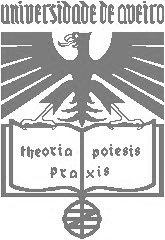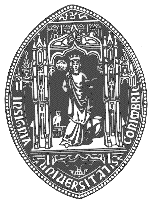11th
European Intensive Course on Complex Analysis
and applications to partial differential equations |
|||||||||||||||||||||||||||||||||
|
Departamento de Matemática,
Universidade de Coimbra, Portugal
|
|||||||||||||||||||||||||||||||||
| Goal of the Course | |||||||||||||||||||||||||||||||||
|
This intensive course follows the ten held at the Universities of Coimbra and Aveiro from 1995 to 2004 (1995, 1996, 1997, 1998, 1999, 2000, 2001, 2002, 2003, 2004) and there are plans for intensive courses in the following years. The lecture notes of some of the courses have been published in Coimbra and others are in print. This intensive course will have a total of 40 hours of lectures and is at postgraduate level. Lecturers will have time available to discuss with the students. Successfully participating students will get a certificate. This course is organized by the Universities of Coimbra and Aveiro with the same goals as the ones organized under the Socrates/Erasmus Intensive Program of Higher Education, and is opened to all young mathematicians interested in Complex Analysis and its applications. There will be a Workshop on "Applications and Generalizations of Complex Analysis" on the 4th of June 2005. |
|||||||||||||||||||||||||||||||||
|
|||||||||||||||||||||||||||||||||
|
|||||||||||||||||||||||||||||||||
|
|||||||||||||||||||||||||||||||||
| Title: Orthogonal Polynomials on the unit circle. From Gabor Szegö to Barry Simon | |||||||||||||||||||||||||||||||||
| Summary: In
the last ten years an increasing effort in the theory of
orthogonal polynomials with respect to probability measures supported
on the unit circle has been done. The very recent monograph by Barry
Simon constitutes a good example of the fact how a well stated theory
can be renewed using innovative tools and approaches coming from other
areas of mathematics as well as from applications. The aim of this set of lectures is to present the basic background in the theory stated by Gabor Szegö in the thirties and intensively developed from an analytic point of view during the second half of the last century by Ya. Geronimus, P. Nevai, E. Rakhmanov among others. |
|||||||||||||||||||||||||||||||||
|
This overview will cover the following topics: 1.- Orthogonal polynomials on the unit circle. Verblunsky coefficients. Carathéodory and Schur functions. 2.- Szegö's Theorem. 3.- Geronimus Theorem. 4.- CGT and CMV representations. Spectral consequences. 5.- Rakhmanov,s Theorem. |
|||||||||||||||||||||||||||||||||
|
References: B. Simon, Orthogonal Polynomials on the unit circle, Part I: Classical Theory. Part II: Spectral Theory, Colloquium Applications, Volume 34, American Mathematical Society, Providence, Rhode Island, 2005. |
|||||||||||||||||||||||||||||||||
|
|||||||||||||||||||||||||||||||||
|
|||||||||||||||||||||||||||||||||
| Title: Monogenic, hypermonogenic and holomorphic Cliffordian functions | |||||||||||||||||||||||||||||||||
| Summary: The Clifford algebras are generalizations of the field of complex numbers. The concept of holomorphic function of a complex variable may be extended to these realms in several ways. We will study three classes of functions generalizing the holomorphic functions: the monogenic functions, the hypermonogenic functions and the holomorphic Cliffordian functions. We will stress the the interrelation between these classes of functions in different dimensions. We end the course by some application, for instance we will build and study the Cliffordian elliptic functions, which is a nice shortcut to the ordinary elliptic functions. | |||||||||||||||||||||||||||||||||
|
|||||||||||||||||||||||||||||||||
| Title: Transform Analysis: The Hilbert Transform | |||||||||||||||||||||||||||||||||
| Summary:
The first part of the course treats the Hilbert Transform, which is basic in the classical theory of the singular integral operators. The Hilbert Transform is at the crosspoint of real and complex analysis and fundamental to the study of boundary values of Cauchy transforms of
L2-functions on the real line, the unit circle, half-space and the unit sphere. It leads to the study of Hardy spaces of harmonic, holomorphic and monogenic functions. The Hilbert Transform is used in the theoretical description of electronic devices and systems, and the elements of the Hardy space, the so-called analytic signals, are fundamental to the theories of signals, circuits and
systems. The concept of Hilbert transform is first introduced in the complex plane (on the real line and on the boundary of bounded regions), but the course especially focusses on the study of the Hilbert transform in Euclidean space, in the framework of Clifford analysis. |
|||||||||||||||||||||||||||||||||
|
|||||||||||||||||||||||||||||||||
| Title: Transform Analysis: The Continuous Wavelet Transform | |||||||||||||||||||||||||||||||||
| Summary:
The second part of the course treats the Continuous Wavelet Transform
[CWT]. The CWT belongs, such as the Windowed Fourier Transform or Gabor
Transform, to the class of time-frequency representations of signals. These representations
are, contrary to the classical Fourier Transform, particularly suited for the
analysis of non-stationary, inhomogeneous signals. Many applications amply
demonstrate that the CWT is a successful tool for the analysis of signals and
feature detection in signals. First the concept of the CWT is introduced on the real line and in Euclidean space. Then a unifying construction of multi-dimensional wavelets, in the framework of Clifford analysis, is presented. Starting point for this construction of Clifford-wavelets, is the introduction of new polynomials in Euclidean space, generalizing classical orthogonal polynomials. A selection procedure leads to specific Clifford mother wavelets such as the Clifford-Hermite, the Clifford-Gegenbauer and the Clifford-Laguerre wavelets. |
|||||||||||||||||||||||||||||||||
|
Living expenses can be partially covered for some students if they do not have support from their own institution and if there is enough money available. |
|||||||||||||||||||||||||||||||||
| Anabela Monteiro Paiva, Universidade da Beira Interior, Portugal | |||||||||||||||||||||||||||||||||
| Hennie De Schepper, University of Ghent, Belgium | |||||||||||||||||||||||||||||||||
| Gil Bernardes, Universidade de Coimbra, Portugal | |||||||||||||||||||||||||||||||||
| Jarkko Kettunen, Tampere University of Technology, Finland | |||||||||||||||||||||||||||||||||
| José Carlos Soares Petronilho, Universidade de Coimbra, Portugal. | |||||||||||||||||||||||||||||||||
| Joana Soares, Universidade do Minho, Portugal | |||||||||||||||||||||||||||||||||
| Luis Manuel da Silva Cotrim, Instituto Politécnico de Leiria, Portugal | |||||||||||||||||||||||||||||||||
| Maria Francisca Matos Cabo, Universidade de Coimbra, Portugal | |||||||||||||||||||||||||||||||||
| Maria das Neves Vieiro Rebocho, Universidade da Beira Interior, Portugal | |||||||||||||||||||||||||||||||||
| Milton Ferreira, Universidade de Aveiro, Portugal. | |||||||||||||||||||||||||||||||||
| Nelson Faustino, Universidade de Aveiro, Portugal. | |||||||||||||||||||||||||||||||||
| Nelson Vieira, Universidade de Aveiro, Portugal. | |||||||||||||||||||||||||||||||||
| Roberto Costas Santos, Universidad Carlos III de Madrid, Spain | |||||||||||||||||||||||||||||||||
| Sandra Orfăo, Aachen University, Germany. | |||||||||||||||||||||||||||||||||
|
|||||||||||||||||||||||||||||||||
| With support from CMUC (Centro de Matemática da Universidade de Coimbra), UI&D "Matemática e Aplicaçőes" da Universidade de Aveiro, and the Socrates programme |
|
 |
 |
||||||||||||||||||||||||||||||
